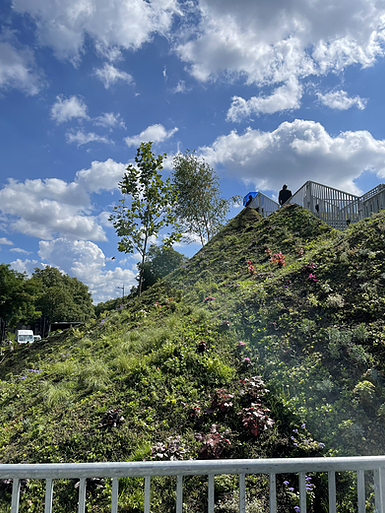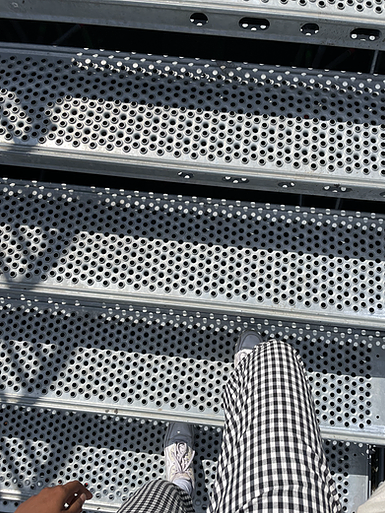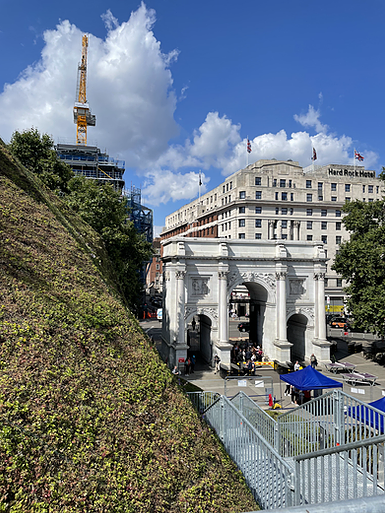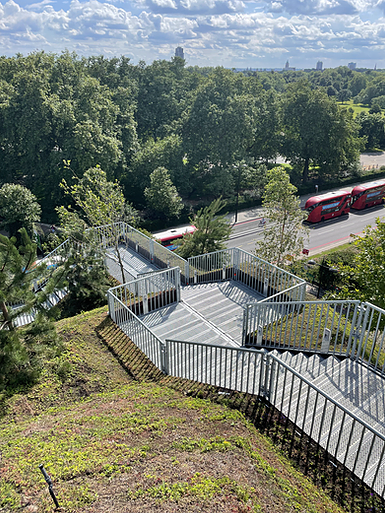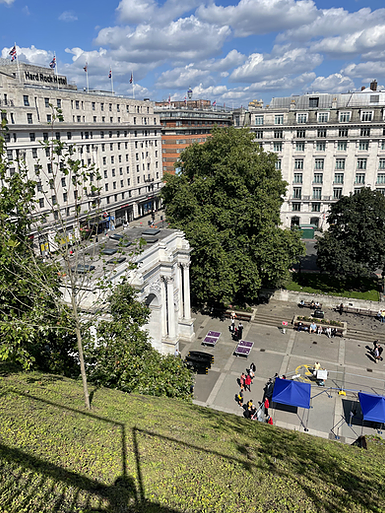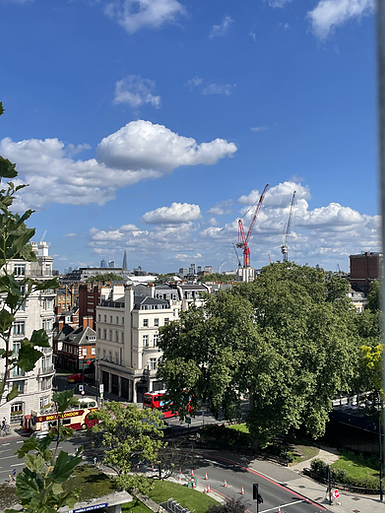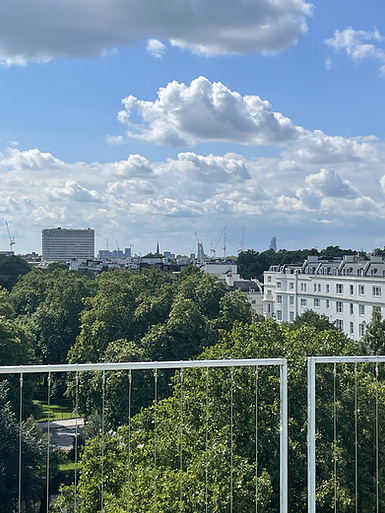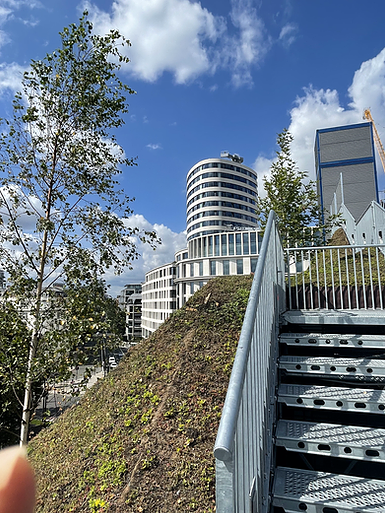Marble Arch Mound
ZM
Emoji summary: 🪨⛰ 🏔️ 🕳️
I think I am a person who gets obsessed easily. I like picking things up, carrying them around with me every day for about 2 weeks, and then just dropping them, never to pick them back up ever again. It is a pattern I notice in myself; I do it with clothes, music, little knick-knacks, boys, bits of pop culture detritus. At times it makes me feel like an adult-sized-baby, but for the most part I like having these glimmering infatuations. I get swept along with the same energy and excitement of a high-school crush, and when it fizzles out, a new shiny toy comes along to fill the gap. I have a sagittarius rising, can you tell?
My most recent crush has been on the Marble Arch mound.
The Marble Arch mound is kind of what it says on the tin: it’s just a big grassy mound right next to Marble Arch. There’s a big chunky metal stairway that carves a path around the side, and you can climb up to a flat top where there’s a touristy viewing platform. I first saw it on twitter; Gab sent me a link to Dan Barker’s thread about it, and as I read through, I was hooked from the jump. It cost £2million. It was designed by MVRDV, a Dutch architectural firm, and commissioned by Westminster City Council. The aim was: to create a temporary monument-as-spectacle, drawing people to the West End, to reinstate a little green corner and simulate a mini ~great outdoors~ in the city, to give visitors a new perspective and relink the stretch of road from Hyde Park down to Oxford Street.
Truthfully, I don’t really care about the aims or intentions, the context and background to it all. I just love a spectacle - and more than that, I love a failed spectacle. I am a rubber-neck-er, a gawker. For a few days, the Marble Arch mound went viral as a flop. It had a wobble, where there was news it was going to shut 3 days after it opened, there were headlines calling it a ‘£2m SLAG HEAP’, and then it was open for free, but still under construction. Now, the deputy leader of Westminster council has stepped down, and it’s reported to have cost £6million (!?!?!) And I just know that behind that all is some sitcom faffing, some Parks & Rec local government shambles, with hurried emails and stressed sweaty zoom calls about next steps. I want a Fyre Festival style Netflix documentary taking us behind the scenes.
But after all that, it’s now open to the public for free throughout august, and I went over to have a lil snoop to see what all the fuss was about. I scanned my ticket at the makeshift marquee entrance, did the bag check and clanged up the wide metal steps to the top. The viewing platform was only about 5/6 storeys up, I ended up eye level with a couple of the buildings surrounding it, but I could look down on the tops of some trees through the metal protective railings. If you squint on a clear day, you can see the taller landmarks closer to the river: the shard, the London Eye, the Cheese Grater. Beyond and further, the skyscrapers of Canary Wharf peek out, red light blinking between the side of a building and a cloud. It’s fun to get high up in a city, something thrilling in that ancient caveman brain lobe that’s in charge of our emotional response to colours and seasickness. But something about it didn’t quite hit right; maybe it’s that it’s not that high, obstructed by trees and office blocks, maybe bc I could quite literally see other buildings where I know there’s a better view, where the building sites on the ground beneath you are just further away and you’re more snug and cosy tucked up in the clouds. It felt silly, or like something was deflating within me, something that had gradually swelled as I climbed up.
More interestingly: I could see down, onto the top of marble arch. It looked like there was a cluster of skylights on the roof, which must mean it’s hollow?? I wanted to be in there instead. Or maybe I wanted to be scaling up the side, getting ready to abseil down the height of it. Surely being inside Marble Arch would be like sitting in a giant piggy bank. I imagine it would clink when you knock on the walls, like a comically big ceramic souvenir. Maybe there is a cafe and gift shop at the top, where you can buy a little cake, a postcard and a keyring.
I want to give the Marble Arch Mound the full art critic treatment, hold it up and look at it from all angles, try and get it to speak to me in some voice of truth. I want to pretend I am an alien, or an archeologist from the future, so I can ask: What does the Marble Arch Mound tell us about the culture and society that made it?
Let’s start with the basics. It is big, it is green, it is hollow, it is spectacular, it is slightly reviled by a public that feels affronted by its uselessness. It cost SIX MILLION POUNDS. It is not finished. It was built with a primary purpose of actively facilitating capitalist modes of exchange, everything else is kind of a secondary function. It is intended as a monument, but its power as a monument is gathered by proxy; it quite literally overshadows a massive and iconic London landmark, but it is also a kind of parasite. It is described as public space, but it is ticketed and fenced off. It is politely policed by staff that look like they’re there to do customer service, but they’re wearing walkie talkies and watching you carefully. It is private space that bears the intentional markers of public space, like public-ness is an aesthetic or a vibe to deploy and instrumentalise, for a metropolitan audience that has endured 11ish years of public funding being cut back to the bare bones.
I want to hold the mound up and parse its meaning, because I think that through the mound, I might be able to land on a wider truth. I think there’s something politically specific about public art that deals in a monotone of big spectacles. Because what actually is a spectacle? What are spectacles meant to do? Well, spectacles are visual, they are dramatic, striking, they are memorable for their fabulous appearance, that glossy surface your eyes skim across. If I was the kind of critic that quoted French theorists, I’d tell you the academic details of how they function as distraction. But most of all, spectacles are symbolic. They simulate something that exists out in the real world, and they play that out on a theatrical plane that is sanitised of the crust and crud that complicates real life. Maybe sometimes that sanitary theatrical plane opens up space to refine a thing into a state of abstract purity, so you can see a society through a clearer lens.
But the Marble Arch Mound isn’t a fantastic spectacle, it is a floppy spectacle; so what does that now mean? If you bring the spectacle of the mound into that sanitised theatrical space, I think it looks empty. It isn’t a site-specific intervention, aware of its own convention and context. It is a spectacle for spectacle’s sake, it is engineered to be gawked at, to grab people as they walk on by, but only with the sheer volume of itself. It is a MOUND: a mound is just a non-specifically shaped mass. It is just there, a looming lumpen presence, a shadow. It is empty. In real life it is a monument-by-proxy, only containing meaning or accumulating power parasitically, from the actual monument (for better or worse) right next to it. In that sanitised theatrical space, that is conjured by its spectacle-hood, it is a void and vacuum, stripped of the thing that gave it meaning.
If the Marble Arch Mound is an absence of meaning, then that absence still means something. We can still be future alien archaeologists, still try and infer something from our historical source. I think this absence speaks more about the culture and people that produced the mound, than the mound itself. If this was a public artwork in the proper sense, I would look at the funders, the institutions, the organisational bodies around it that made the terms of its display possible. Here, those organisations are: MVRDV (the architectural firm that designed it), Westminster council, and a couple other corporate partners like M&S, BT, W1 Curates, and Marble Arch Business Improvement District. The culture and people that produced the mound are a bunch of corporate entities, and a local council that has an enormous Conservative majority (41 out of 60 councillors).
The Mound makes coherent sense within this framework, it fits smoothly into the art historical canon of this corporate and Conservative cultural lineage. Things like Boris Johnson’s Garden Bridge: an expensive flop, equally empty of symbolic meaning in the theatrical plane, it makes sense next to these things! There’s a likeness! It makes sense against political history, just over a decade of consecutive Conservative governments cutting and cutting and cutting away at public funding, for everything, but specifically for the arts and for culture at large. Before that: Blairite continuation of neoliberalism, privatisation of public assets, specifically the introduction of Public Private Partnerships (that Morgan Quaintance wrote a defining text on: New Conservatism). This corporate recalibration of the arts brings new objects in to draw up contextual lines: the London 2012 Olympics and the Cultural Olympiad, Create London and the professional gentrification machine it unleashes on areas that have been historically deprived of state funding for public services, London Borough of Culture. Bigger and wider: Arts Council England’s <GREAT ART AND CULTURE FOR EVERYONE>, the 10-year strategic framework for 2010-2020, and its focus on ‘building resilience' within cultural institutions and their funding frameworks - in practice, this meant an increasing reliance on private funding, the monetisation of program and output, and an expectation that institutions could be rebuilt towards financially self-sustaining models. This is all a very long way of saying: the art this corporate, Conservative cultural lineage produces is for profit, monetisable, and able to actively facilitate and enable further income sources, in service of capitalist modes of exchange. Within this corporate, Conservative cultural lineage, enjoyment of art and culture by and for the public is purely a secondary function, it is an assumption we can make depending on that primary capitalist function. If business is booming, the public must be enjoying it, and therefore it must be good.
Meaning just kind of dissolves away; this Conservative culture prioritises a bankable business model, the kind that can only realistically be found in professional art institutions - yes yes, Morgan wrote the analysis on that. But institutions are not where culture is made, they are where culture is administrated. Institutions are not productive, they are administrative, or distributive; they rely on artists as a productive workforce. When these institutional bodies are the main site of government funding, and when artists have to struggle through precarious work because of material conditions created by a Conservative government: from end to end, meaning is bust. Nothing actually gets made, but that nothing is very effectively administered.
But even away from the framework and cultural canon the mound sits within, its vacuum of meaning still says something further about the culture that produced it. This bankable business model is a category of art that says nothing, means nothing, and its nothing is on purpose. Against the backdrop of 11ish years of consecutive Conservative governments, Boris Johnson’s Conservative government specifically has an approach to culture that leaves an identifiable pattern. Prioritising income streams, deploying the aesthetic of public services through private space, empty spectacle, demonising and punishing political efforts to rethink relationships to colonial history. This is a cultural category that is fundamentally at odds with the way I am trying to read it right now. I am trying to be a future alien archeologist, looking for clues about the backdrop this cultural object sits against. I want to read it as a political object, or an object capable of containing political implications about the society, culture and people that made it, and the conditions that made its making possible. Boris Johnson’s Conservative government creates cultural conditions that favours big monuments, spectacles and vanity projects. It neatly and politely avoids all of the political stickiness that actually comes with weight, value or meaning. These conditions favour the empty looming mass, and in that absence, it falls back on what it knows: The Professional, The Corporate, the artist as business person. Culture becomes slicker, more of a booming industry than a public service.
So now, my future alien archeologists. I have a loaded question for you: If the Marble Arch Mound is a monument(-by-proxy), what is it a monument to? I have a sad answer, that is just my humble opinion dressed up as a hot take. The Marble Arch Mound is a monument to Conservative cultural policy, and it is a monument to the future of public art under another decade of Conservative government. I want to hold it up as a warning. I want to knock on doors and wave it in peoples’ faces, like the crank I truly am. I want to scream, ‘LOOK WHAT THEY’VE DONE!!! WE USED TO SING FOR THE JOY OF IT!!!! AND LOOK WHAT THEY DID TO OUR SONGS!!!!’ A mound, a mass, a lumpen shadow. I am obsessed with the Marble Arch Mound, fascinated by it in the same way I would feel myself automatically slow down to look at a car crash. I would twist my neck all the way round to catch a glimpse of the burnt out husk of it, despair and feel a deep sadness grip my throat.
